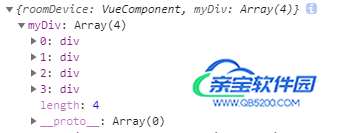vue 循环动态设置ref并获取$refs方式
zeng092210 人气:0vue循环动态设置ref并获取$refs
关于ref的使用和场景请看官网文档
下面是我对循环设置ref并获取使用的一些办法,简单记录一下
一. 使用理解步骤(个人理解、大白话概况)
单循或双循环标签使用,无论那种都要**保证ref唯一**
例如:可以在ref值后面附带id或不会重复的索引
针对上述唯一的ref进行获取
获取:单循环可以直接用$refs获取非单循环可以通过eval()获取
二. 单循环和无循环动态设置ref
设置 【ref=“xxx”】【ref="‘xxx’+index"】
就不多说了 简单
三. 双循环动态设置ref
设置【:ref="‘xxx’+id"】或【:ref="‘xxx’+index"】
<div v-for="(item,index) in topicList" :key="index"> <el-carousel-item v-for="(son,i) in item.questionList" :key="index+i"> <topic :ref="'topicRef'+son.bId"></topic> //或也可以用索引. 用一个索引会重复,如下 //<topic :ref="'topicRef'+(i+index)"></topic> </el-carousel-item> </div>
获取
eval("that.$refs.tagItem" +(x+index))[0]或
eval("that.$refs.topicRef" +(ele.bId))[0]ref和$refs的使用方法
在JavaScript中需要通过document.querySelector("#demo")来获取dom节点,然后再获取这个节点的值。
在Vue中,我们不用获取dom节点,元素绑定ref之后,直接通过this.$refs即可调用,这样可以减少获取dom节点的消耗。
ref介绍
ref被用来给元素或子组件注册引用信息。引用信息将会注册在父组件的 $refs对象上。如果在普通的 DOM 元素上使用,引用指向的就是 DOM 元素;如果用在子组件上,引用就指向该子组件实例
通俗的讲,ref特性就是为元素或子组件赋予一个ID引用,通过this.$refs.refName来访问元素或子组件的实例
<p ref="p">Hello</p> <children ref="children"></children>
this.$refs.p this.$refs.children
this.$refs介绍
this.$refs是一个对象,持有当前组件中注册过 ref特性的所有 DOM 元素和子组件实例
注意: $refs只有在组件渲染完成后才填充,在初始渲染的时候不能访问它们,并且它是非响应式的,因此不能用它在模板中做数据绑定
案例一、ref 写在标签上时
<!-- ref 写在标签上时:this.$refs.名字 获取的是标签对应的dom元素
ref 写在组件上时:这时候获取到的是 子组件(比如counter)的引用-->
<div id="root">
<!-- ref = 'hello': 给div 起了一个引用的名字 hello -->
<div
ref = 'hello'
@click = "handleClick">
laugh yourself
</div>
</div>
<script>
var vm = new Vue({
el: '#root',
methods: {
handleClick: function() {
//this.$refs : 获取整个Vue实例中所有的引用 然后再找到hello这个引用 指向div那个dom节点
//console.log(this.$refs.hello)
alert(this.$refs.hello.innerHTML)
}
}
})
</script>
案例二、 ref 写在组件上时
计数:
<!-- ref 写在标签上时:this.$refs.名字 获取的是标签对应的dom元素
ref 写在组件上时:这时候获取到的是 子组件(比如counter)的引用-->
<div id="root">
<!-- 子组件触发了事件 这里父组件(模板区里面)监听该事件 调用handleChange方法
因此handleChange方法定义在父组件的methods里面-->
<counter ref="one" @change="handleChange"></counter>
<counter ref="two" @change="handleChange"></counter>
<div>{{total}}</div>
</div>
<script>
Vue.component('counter', {
template: '<div @click="handleClick"> {{number}} </div>',
data: function() {
return {
number: 0
}
},
methods: {
handleClick: function() {
this.number ++
//子组件向父组件传值 子组件被点击的时候 number+1 同时告诉外面 也即是触发一个事件
this.$emit('change')
}
},
})
var vm = new Vue({
el: '#root',
data: {
total: 0
},
methods: {
handleChange: function() {
//在此方法中计算两个数量的和 通过this.$refs.引用名字 获取两个子组件的引用
this.total = this.$refs.one.number +
this.$refs.two.number
}
}
})
</script>
注意:
当ref和v-for一起使用时,获取到的引用将会是一个数组,包含循环数组源
<template>
<div>
<div ref="myDiv" v-for="(item, index) in arr" :key="index">{{item}}</div>
</div>
</template>
<script>
export default {
data() {
return {
arr: ['one', 'two', 'three', 'four']
}
},
mounted() {
console.log(this.$refs.myDiv)
},
methods: {}
}
</script>
<style lang="sass" scoped>
</style>
实例(通过ref特性调用子组件的方法)
【1】子组件code:
<template>
<div>{{msg}}</div>
</template>
<script>
export default {
data() {
return {
msg: '我是子组件'
}
},
methods: {
changeMsg() {
this.msg = '变身'
}
}
}
</script>
<style lang="sass" scoped></style>【2】父组件code:
<template>
<div @click="parentMethod">
<children ref="children"></children>
</div>
</template>
<script>
import children from 'components/children.vue'
export default {
components: {
children
},
data() {
return {}
},
methods: {
parentMethod() {
this.$refs.children //返回一个对象
this.$refs.children.changeMsg() // 调用children的changeMsg方法
}
}
}
</script>
<style lang="sass" scoped></style>总结
以上为个人经验,希望能给大家一个参考,也希望大家多多支持。
加载全部内容